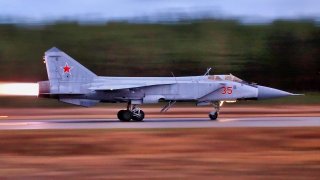Peter Suciu

The Mystique of the MiG-31 Lives On - Last week, the Russian Aerospace Forces announced that it had struck targets in Ukraine with Kh-47 Kinzhal hypersonic missiles fired from Mikoyan MiG-31 jet fighters. The Ukrainian Air Force confirmed the missile launches in the vicinity of Starokostiantyniv in the Khmelnytskyi region by Russian forces.
In October, Russian state media outlet Tass reported that MiG-31 fighters armed with hypersonic weapons would begin conducting patrols over the Black Sea, on the orders of Russian Federation President Vladimir Putin.
"In fulfillment of the political decision by the country's leadership, MiG-31 aircraft with Kinzhal missiles are ready for patrolling in the airspace over the Black Sea and are just waiting for an order to come," a Kremlin told Tass.
The MiG-31 (NATO reporting name Foxhound) aircraft were escorted by Sukhoi Su-27 (NATO reporting name Flanker), the Kremlin announced.
It was also in October that MiG-31 fighters in service with the Russian Navy's Northern Fleet conducted dogfight drills at stratospheric altitudes.
During the training exercises, a MiG-31 fighter was reported to have climbed to an altitude of over 11,000 meters over the Barents Sea where it intercepted and notionally destroyed an intruder.
The Mikoyan MiG-31 in the Crosshairs
The long-range, two-seat supersonic aircraft has maintained a certain mystique in the West, in part because there remains much speculation over all of its capabilities.
Developed for the Soviet Air Forces at the Mikoyan design bureau as a replacement for the MiG-25 (NATO reporting name "Foxbat"), it took its maiden flight in September 1975 and was designed to work efficiently in all weather conditions.
It is considered to be among the fastest combat jets in the world and is expected to remain in service until at least the mid-2030s.
The MiG-31 is equipped with state-of-the-art digital avionics, and unlike the MiG-25, it has two seats, with the rear occupied by a dedicated weapon systems officer. Its reported airframe comprises 49 percent arc-welded nickel steel, 33 percent light metal alloy, 16 percent titanium, and two percent composites.
The MiG-31 also was designed to work efficiently in all weather conditions, while its highly aerodynamic and streamlined body enabled it to fly at low altitudes with required supersonic speeds. It is equipped with efficient low-bypass-ratio turbofan engines, which allow an increase in combat range.

Though the MiG-31 was not developed for close combat or rapid turning, it was the first soviet fighter aircraft to have true look-down and shoot-down capability, while it could track multiple targets simultaneously at high altitudes.
The MiG-31's Zaslon radar was the world's first phased-array unit, which had a range of 200 km. It could track 10 targets simultaneously, and control the engagement of 4 of them at once. Until 2001 – when the Japanese Mitsubishi F-2 with an advanced phased-array radar was adopted – the MiG-31 was the world's only serial fighter aircraft to be equipped with such a phased-array radar.
The upgraded MiG-31BM is further reported to employ R-33 long-range air-to-air missiles and R-73 short-range air-launched weapons. It is powered by two D-30F6 engines, which provide a take-off thrust of 15,500 kgf each, and the fighter-interceptor has a maximum speed of 3,000 km/h and a ceiling of 20,600 meters. It is also outfitted with a mid-air refueling system. It is unknown how many of the original MiG-31s have been upgraded to the 31BM standard, but it has been reported that it is less than 100 of the original 500 aircraft produced during the Soviet era.
The MiG-31 Vs. the SR-71 – The Foxhound and the Blackbird
There have been rumors that during the late Cold War, a MiG-31 Foxhound may have been used to chase after the U.S. military's SR-71 Blackbird spy plane and reportedly locked on with its missiles. Still, as the American reconnaissance aircraft was never employed to actually overfly Soviet airspace, this story seems dubious.
Whether the incident occurred has remained a matter of conjecture at best, however, at least one former Soviet pilot believes the MiG-31 would have had the upper hand.
"If the SR-71 had violated Soviet airspace, a live missile launch would have been carried out. There was practically no chance that the aircraft could avoid an R-33," explained Major Mikhail Myagkiy, retired Soviet MiG-31 pilot, according to TheAviationGeekClub.com.
A Terror Weapon
Despite its touted capabilities, the MiG-31 hasn't served as an interceptor in Ukraine – rather it has proven to be a capable attack aircraft that Kyiv takes very seriously, and with good reason. The supersonic fighter is capable of carrying Kinzhal ballistic missiles. Because those missiles travel at very high speeds and have a long range, every time a MiG-31 takes off from a Russian military base near Ukraine, an air raid alert is issued across the entire country, sometimes lasting for hours.

As the Kyiv Post recently reported, "A lot of businesses in Ukraine have a safety policy of closing during air raid alerts so the warnings triggered by MiG-31s are highly disruptive to the Ukrainian economy. Russia has learned that it can shut down a large chunk of Ukrainian business simply by putting one MiG-31 in the air and leaving it to fly around for a while."
No comments:
Post a Comment